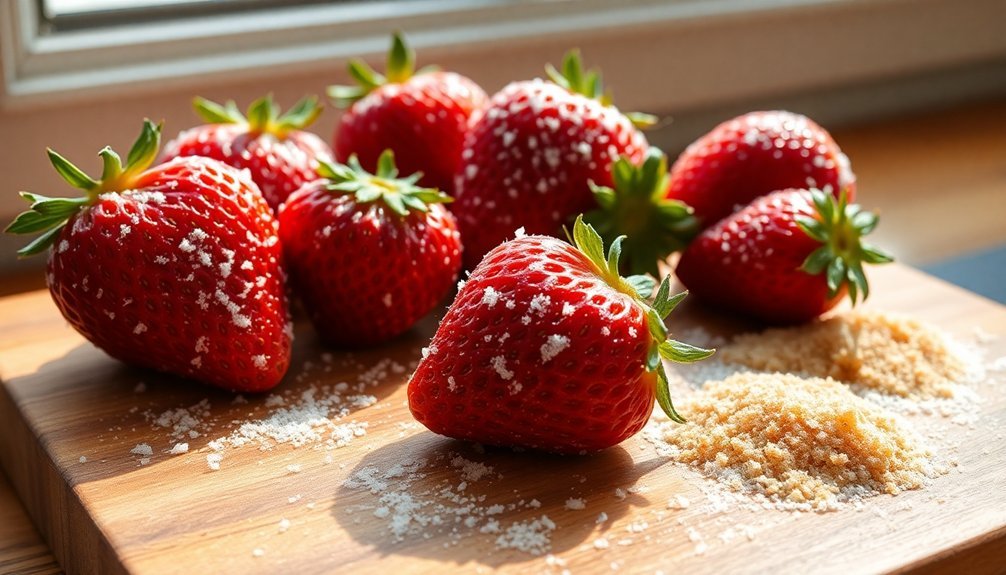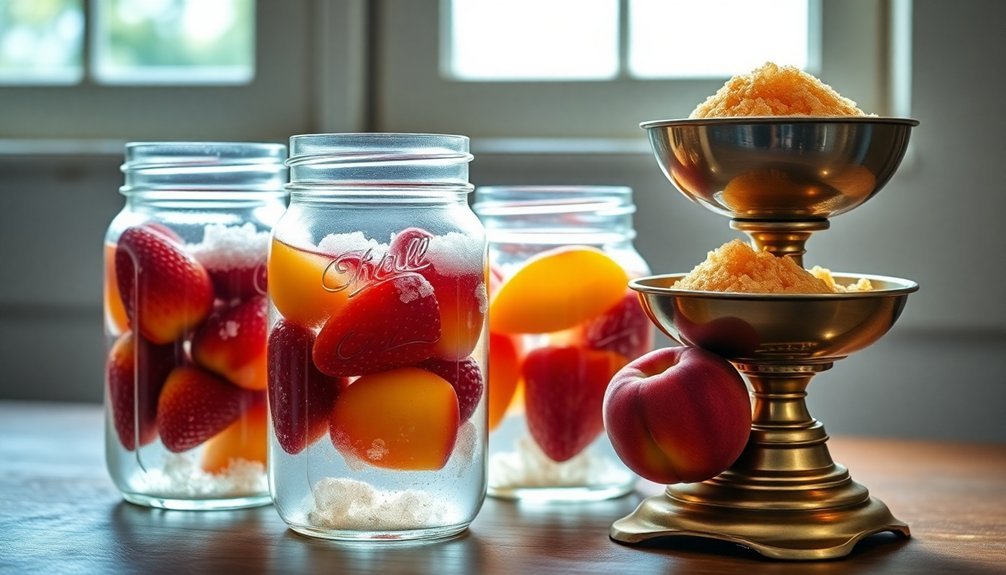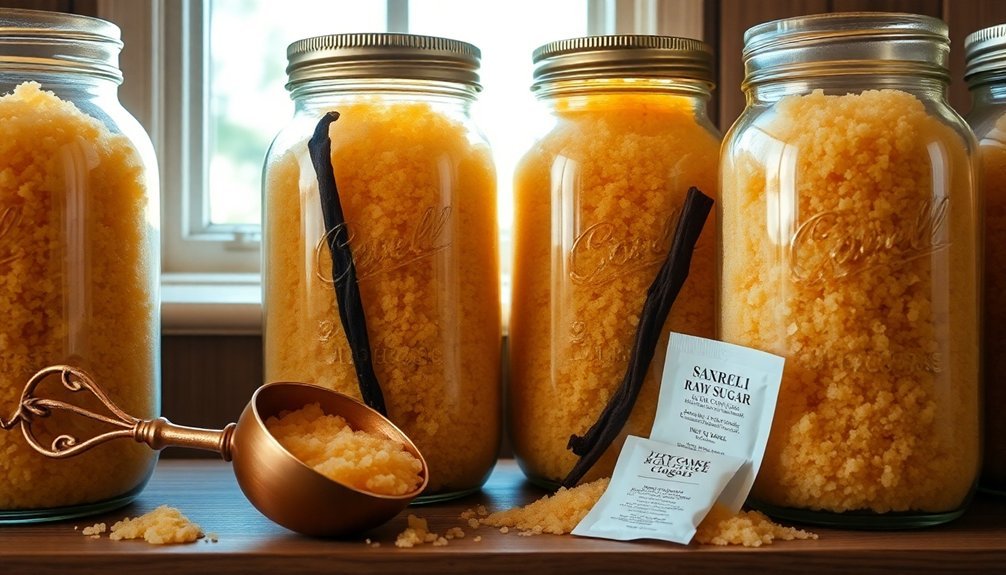Raw sugar offers seven effective preservation methods you can easily master. You'll get ideal results coating firm fruits in raw sugar using egg whites as a natural adhesive. Create lasting syrups by combining equal parts sugar and water, then heating to 186°F. For fruit preserves, stick to a 2:1 fruit-to-sugar ratio for consistent results. Traditional meat curing benefits from raw sugar's natural properties, while citrus preservation simply requires layering peels with sugar in airtight jars. Store your raw sugar properly in glass or ceramic containers, and extend shelf life by adding citric acid or cream of tartar. These sweet techniques are just the beginning of your preservation journey.
Fruit Coating With Raw Sugar

With the right technique, coating fruit in raw sugar creates a stunning crystalline finish that's both beautiful and delicious.
You'll need to start with firm, less ripe fruit at room temperature, making certain it's thoroughly washed and dried to guarantee proper sugar adhesion.
For the best results, you'll want to use superfine or caster sugar rather than regular granulated sugar, as it adheres more effectively to the fruit's surface.
Start by dipping your fruit in lightly beaten egg whites, which act as a natural adhesive for the sugar coating. Then, gently roll the fruit in the sugar until it's completely covered, being careful to shake off any excess.
If you're working with smaller fruits, you can skewer them for easier handling during the coating process. Avoid using raspberries and blackberries as their delicate structure breaks easily.
Once coated, place your fruit on a drying rack with wax paper underneath to catch any drips. You'll know you've done it right when you see an even, crystalline coating forming.
If the sugar seems to disappear into the egg white, don't hesitate to apply a second coating.
Store your finished fruit at room temperature with good air circulation to maintain its crisp coating.
Natural Syrup Preservation Methods
Moving beyond fruit coating, natural syrup preservation requires careful attention to sugar concentration and storage methods.
You'll want to aim for a sugar concentration of at least 50 brix, using equal parts sugar and water by weight. For longer shelf life, opt for rich simple syrup with a 2:1 sugar-to-water ratio.
You can enhance preservation by combining multiple methods. Adding 15% or more alcohol creates an inhospitable environment for microbes, while incorporating citric acid or lemon juice helps maintain stability. Using Campden tablets helps eliminate unwanted bacteria and prevents fermentation in your syrup.
If you're planning for long-term storage, consider pasteurizing your syrup at 186 degrees for 6 seconds or 140 degrees for 10 minutes using the hot fill method.
Don't forget the importance of proper straining and storage. You'll need to strain your syrup thoroughly to achieve a uniform consistency.
Store your preserved syrups in airtight, moisture-proof containers, and keep them in the fridge or freezer for maximum longevity. When freezing, use plastic containers or tempered glass to prevent breakage.
Remember to avoid extreme temperature fluctuations that could lead to crystallization, and you'll maintain your syrup's quality for extended periods.
Perfect Sugar-to-Fruit Ratios

Successfully preserving fruit starts with mastering the right sugar-to-fruit ratios. While traditional recipes often call for equal parts sugar and fruit by weight, you'll get better results using a 60:40 fruit-to-sugar ratio. This proportion allows the fruit's natural flavors to shine while guaranteeing proper preservation and jelling.
For sweeter fruits like figs, you can reduce the sugar to 70% of the fruit's weight. You'll need to weigh your ingredients carefully, as fruit sizes vary considerably and can affect your measurements. Nonreactive canning kettles are essential equipment for achieving consistent results.
If you're looking for a simpler approach, try the 2:1 fruit-to-sugar ratio, which works well for most preserves.
Remember that sugar isn't just for sweetness – it's essential for preservation. You'll want to achieve a final sugar concentration of 60-65% to guarantee your preserves stay safe and maintain their quality.
If you reduce the sugar content, you'll need to compensate with longer cooking times and possibly add pectin to achieve the right set. For testing, place a spoonful on a frozen plate – if it reaches your desired consistency, you're ready to jar your preserves.
Traditional Sugar Curing Techniques
Traditional sugar curing transforms ordinary meats into flavorful delicacies through three proven methods: dry curing, brine curing, and combination curing.
In dry curing, you'll apply the cure mixture directly onto your meat, then seal it in a plastic food storage bag and refrigerate it. You'll need to cure for 7 days per inch of thickness, and don't forget to rinse off excess salt afterward.
If you're using the brine method, also known as sweet pickle cure, you'll submerge your meat in a solution of curing salt and water. You can speed up the process by injecting the brine directly into the meat. Plan for 3 1/2 to 4 days per pound, and remember to change your brine solution weekly to prevent spoilage.
The combination method merges both techniques, using dry rub and brine injections. You'll cure the meat both inside and out, which reduces spoilage risk and shortens curing time.
The sugar in your cure isn't just for taste – it enhances color development and works with nitrates and nitrites for proper curing. You can use various sugars like sucrose, cane sugar, or dextrose, but don't overdo it – sugar is self-limiting due to its sweetening power.
Raw Sugar Storage Solutions

Your raw sugar's longevity depends on choosing the right container, with glass jars, food-grade plastic, and ceramic canisters offering excellent protection against moisture and contamination.
You'll want to guarantee your containers have tight-fitting lids and are completely airtight to prevent clumping and maintain freshness.
For the longest possible storage life, you can combine proper containers with vacuum sealing or oxygen absorbers, while keeping your sugar in a cool, dry place away from direct sunlight.
Moisture-Proof Container Options
For ideal raw sugar storage, selecting the right moisture-proof container makes all the difference between preserving quality and dealing with unwanted clumping. You'll find several reliable options that can keep your raw sugar fresh and dry for extended periods.
Glass jars offer excellent protection with their airtight seals, while food-grade plastic containers provide a practical solution for long-term storage. If you're looking for durability, ceramic canisters with tight-fitting lids or stainless steel containers will serve you well, as they're both moisture-proof and sturdy.
When choosing your container, make certain it's completely airtight and opaque to protect against both moisture and light exposure. If you're storing large quantities, consider food-grade buckets with gamma seal lids.
While polyethylene and Mylar bags are available options, they're not your best choice unless you place them inside a rigid, airtight container.
To enhance your storage setup, you can add desiccant or silica gel packets to maintain dry conditions. Remember to thoroughly clean and dry your chosen container before adding sugar, and store it in a cool, dry place with temperatures between 50-80°F.
Long-Term Storage Tips
Raw sugar storage success depends on mastering a few essential long-term preservation techniques.
You'll want to focus on maintaining consistent temperature conditions between 50-80°F and keeping humidity levels below 60%. When you're setting up your storage area, choose a location away from direct sunlight and heat sources to prevent quality degradation.
For the longest shelf life, you'll find vacuum sealing particularly effective, as it can preserve your raw sugar for up to two years by eliminating air exposure. If you're storing bulk quantities, consider using food-grade drums with moisture barriers, and add desiccant packets to absorb any excess moisture that might cause clumping.
Don't use oxygen absorbers, though, as they'll actually promote hardening.
You can also freeze raw sugar in airtight containers for extended preservation. Remember to implement a first-in, first-out rotation system and label your containers with purchase dates to track freshness.
If you notice your sugar becoming hard or lumpy, don't worry – it's still perfectly usable. You can restore its granular form by running it through a food processor or use it directly in recipes where it'll be dissolved.
Preserving Citrus Using Raw Sugar
Through the art of preservation, citrus peels can be transformed into delightful candied treats using raw sugar's natural properties. You'll want to start with fresh, organic citrus fruits that are free from bruises, cuts, and preservative wax.
Carefully remove the peel using a vegetable peeler or sharp paring knife, making sure to minimize the white pith.
The preservation process relies on sugar's ability to draw moisture from the citrus peel cells through osmosis, which naturally preserves the peels and reduces their bitterness. You'll need to layer the citrus peel strips with raw sugar in a clean, dry jar, starting with a couple tablespoons of sugar at the bottom.
Don't overcrowd the jar, and leave about two fingers of space at the top for shaking.
Store your preserved citrus in an airtight container away from direct sunlight. If you're using a method that includes juice and salt, keep it refrigerated with all contents submerged.
You'll need to wait about three weeks before using your preserved citrus, and always use utensils to remove the peels to prevent bacterial contamination.
Extended Shelf Life Sugar Tricks

While preserving citrus relies on sugar's osmotic properties, there are several proven techniques to extend the shelf life of any sugar-based preservation. You'll find that combining multiple preservation methods creates the most effective results.
| Method | Technique | Effect |
|---|---|---|
| Sugar Ratio | Use 50% or higher | Reduces water activity (aw) |
| Alcohol Addition | Add 15%+ alcohol | Creates preservative environment |
| Heat Treatment | Heat to 186°F/6s or 140°F/10m | Pasteurizes solution |
| Acid Balance | Add citric acid/cream of tartar | Lowers pH |
| Hot Fill | Pour at 120°F+ and invert | Creates vacuum seal |
You'll get the best results when you combine high sugar concentrations with acidification. For example, if you're making a syrup, start with a 1:1 sugar-to-water ratio, then add a splash of lemon juice or cream of tartar. For extra protection, consider adding alcohol at 15% concentration. When bottling, heat your mixture to at least 186°F for 6 seconds, then pour it into sterilized containers while still hot (above 120°F). Don't forget to invert the bottles briefly after sealing to create that vital vacuum effect.
Frequently Asked Questions
Can Raw Sugar Be Used for Dehydrating Fruits Without Additional Heat?
No, you can't use raw sugar alone to dehydrate fruits without heat. You'll need proper dehydration methods involving heat (115°F-145°F) to effectively remove moisture and preserve the fruit's quality.
Does Raw Sugar Affect the Nutritional Content of Preserved Fruits Differently?
While you'll get the preservative benefits, raw sugar doesn't change how nutrients behave in preserved fruits. However, it does add empty calories and can reduce the overall nutritional value of your preserved fruit.
How Do Different Raw Sugar Grain Sizes Impact Preservation Results?
You'll get better preservation results with larger sugar grains (>1.000 mm) since they're less likely to cake or dissolve. They'll maintain stability longer and won't form unwanted lumps around your preserved foods.
Can Raw Sugar Be Combined With Vinegar for Pickling Preservation?
Yes, you can combine raw sugar with vinegar for pickling. You'll need to guarantee it fully dissolves when boiling the pickling solution. It'll balance the vinegar's acidity while maintaining proper preservation properties.
Will Using Raw Sugar Change the Fermentation Process in Preserved Foods?
Yes, adding raw sugar will alter your fermentation process. It can disrupt the natural bacterial balance, slow down fermentation, and potentially lead to unwanted growth of yeasts that'll interfere with proper preservation.
In Summary
Now you're equipped with seven effective ways to preserve fruits and other foods using raw sugar. Whether you're coating fresh berries, creating natural syrups, or curing citrus peels, these methods will help you extend your food's shelf life naturally. You'll find these preservation techniques not only practical but also cost-effective. Start experimenting with these sugar-based methods, and you'll enjoy your favorite foods longer.





Leave a Reply